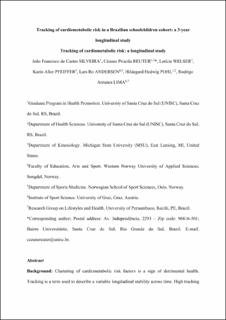| dc.contributor.author | Silveira, João F. | |
| dc.contributor.author | Reuter, Cézane P. | |
| dc.contributor.author | Welser, Letícia | |
| dc.contributor.author | Pfeiffer, Karin Allor | |
| dc.contributor.author | Andersen, Lars Bo | |
| dc.contributor.author | Pohl, Hildegard H. | |
| dc.contributor.author | Lima, Rodrigo Antunes | |
| dc.date.accessioned | 2022-03-21T14:54:39Z | |
| dc.date.available | 2022-03-21T14:54:39Z | |
| dc.date.created | 2021-08-06T09:34:46Z | |
| dc.date.issued | 2021 | |
| dc.identifier.citation | Silveira, J. F., Reuter, C. P., Welser, L., Pfeiffer, K. A., Andersen, L. B., Pohl, H. H., & Lima, R. A. (2021). Tracking of cardiometabolic risk in a Brazilian schoolchildren cohort: a 3-year longitudinal study. The Journal of Sports Medicine and Physical Fitness, 61(7), 997-1006. | en_US |
| dc.identifier.issn | 0022-4707 | |
| dc.identifier.uri | https://hdl.handle.net/11250/2986606 | |
| dc.description | This is an author's accepted manuscript version of an article published by Edizioni Minerva Medica in The Journal of Sports Medicine and Physical Fitness on 23 July 2021, available from https://doi.org/10.23736/S0022-4707.20.11479-8 | en_US |
| dc.description.abstract | Background: Clustering of cardiometabolic risk factors is a sign of detrimental health. Tracking is a term used to describe a variable longitudinal stability across time. High tracking provides the chance to determine which cardiometabolic risk factors should be the target of early treatment and prevention efforts. The present study aims to analyze the tracking of cardiometabolic risk factors and clustered cardiometabolic risk score in children across a 3-year time span, and to verify the odds of staying at risk (measured by the clustered score) from baseline to follow-up. Methods: Longitudinal study that included 354 (155 boys) children, aged 7-12 years at baseline. A clustered score was calculated by summing the systolic blood pressure, waist circumference, triglycerides, glucose, and the TC/HDL-C ratio Z-scores divided by five. A second clustered score was calculated including cardiorespiratory fitness (CRF). Results: CRF and anthropometric parameters presented high tracking (r≥0.662), whereas the cardiometabolic parameters exhibited low-to-moderate tracking (0.100≤r≤0.571). The clustered scores' tracking was moderate (r≥0.508; r≥0.588 [CRF]). Participants in the higher risk groups at baseline presented 3.81 (95% CI: 2.40; 6.05) and 4.64 (95% CI: 2.85; 7.56), including CRF, times higher chance of remaining at risk three years later. Moreover, participants in the worst profile regarding CRF or anthropometrics at baseline presented at least 4.00 times higher chance of being at risk three years later. Conclusions: Participants with worst CRF and adiposity had an increased risk of presenting higher clustered risk after three years. | en_US |
| dc.language.iso | eng | en_US |
| dc.publisher | Edizioni Minerva Medica | en_US |
| dc.title | Tracking of cardiometabolic risk in a Brazilian schoolchildren cohort: A 3-year longitudinal study | en_US |
| dc.type | Peer reviewed | en_US |
| dc.type | Journal article | en_US |
| dc.description.version | acceptedVersion | en_US |
| dc.source.pagenumber | 997-1006 | en_US |
| dc.source.volume | 61 | en_US |
| dc.source.journal | Journal of Sports Medicine and Physical Fitness | en_US |
| dc.source.issue | 7 | en_US |
| dc.identifier.doi | 10.23736/S0022-4707.20.11479-8 | |
| dc.identifier.cristin | 1924308 | |
| cristin.ispublished | true | |
| cristin.fulltext | postprint | |
| cristin.qualitycode | 1 | |
